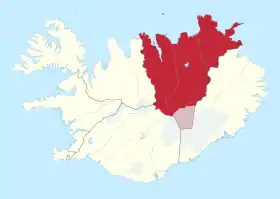Norðurland eystra
Le Norðurland eystra, littéralement « Région du Nord-Est », est l'une des huit régions de l'Islande. Sa capitale est Akureyri, qui est également la plus grande ville de la région.
| Année | Population | Pourcentage de la population islandaise |
| 1920 | 14 222 | 15,06 % |
| 1930 | 16 947 | 15,60 % |
| 1940 | 19 769 | 16,26 % |
| 1950 | 21 776 | 15,09 % |
| 1960 | 22 449 | 12,52 % |
| 1970 | 24 386 | 11,92 % |
| 1980 | 27 703 | 11,98 % |
| 1990 | 27 942 | 10,84 % |
| 2000 | 28 181 | 9,89 % |
| 2011 | 29 006 | 9,08 % |
| Norðurland eystra | |

| |
| Administration | |
|---|---|
| Pays | |
| Type | Région |
| Siège | Akureyri |
| Démographie | |
| Population | 29 006 hab. (2011) |
| Densité | 1,3 hab./km2 |
| Géographie | |
| Superficie | 21 968 km2 |
Principales communes
Municipalités du Norðurland eystra
- Akureyri (17 754 habitants),
- Dalvíkurbyggð (1 960 habitants),
- Eyjafjarðarsveit (1 025 habitants),
- Fjallabyggð (2 030 habitants),
- Grýtubakkahreppur (334 habitants),
- Hörgárbyggð (600 habitants),
- Langanesbyggð (505 habitants),
- Norðurþing (2 905 habitants),
- Skútustaðahreppur (386 habitants),
- Svalbarðshreppur (106 habitants),
- Svalbarðsstrandarhreppur (400 habitants),
- Tjörneshreppur (57 habitants),
- Þingeyjarsveit (944 habitants)
Comtés du Norðurland eystra
Eyjafjarðarsýsla • Norður-Þingeyjarsýsla • Suður-Þingeyjarsýsla
.jpeg.webp) Akureyri et l'Eyjafjörður.
Akureyri et l'Eyjafjörður.
 Le lac Mývatn
Le lac Mývatn L'île de Grímsey
L'île de Grímsey Le volcan Krafla
Le volcan Krafla


- Portail de l’Islande
Cet article est issu de Wikipedia. Le texte est sous licence Creative Commons - Attribution - Partage dans les Mêmes. Des conditions supplémentaires peuvent s'appliquer aux fichiers multimédias.